How to Know if You Have the Right Flange Size
With practically all camera manufacturers having launched several unlike camera systems, there seems to be quite a bit of confusion amidst photographers in regards to camera lens mounts. This is particularly truthful for things similar "pharynx size" and "inner diameter", where dissimilar measurements are used to wrongly quantify a mount'south potential. Unfortunately, there is a lot of misinformation out in that location regarding mounts and their exact sizes, which is why I decided to write a detailed article talking virtually different mounts, their differences and take more precise measurements for unlike systems to present accurate information.
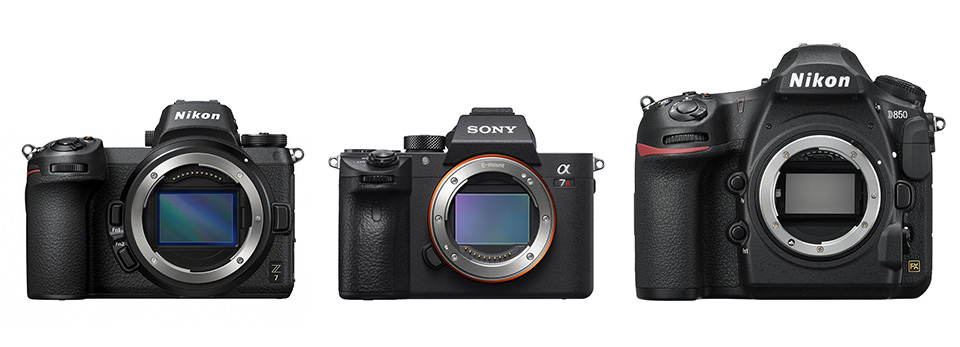
Table of Contents
What is a Lens Mountain?
Simply put, a lens mount is an opening of a specific size on an interchangeable lens camera that allows attaching lenses designed for that mount. Although in the early on days of photography lenses were only mechanically attached to cameras without whatsoever communication between the ii, with the ascent of automatic metering and autofocus systems, it was necessary to create electronic contacts on both cameras and lenses to allow them to communicate with each other. As a result, a lens mountain became more than just a concrete pigsty, but more similar an interface between lenses and cameras.
Today, practically every lens mount for photography is a bayonet mountain (the proper name "bayonet" comes from the type of fitting soldiers used on their rifles to rapidly mountain bayonets), where three to four tabs are used to lock a lens tightly in place, only other lens zipper systems have been used in the by, such every bit screw-threaded lock and breech-lock. With a bayonet mount, one aligns a marked section of a lens (typically a colored dot) with the marked section on a photographic camera body, so after coupling the two, twists the lens either in clockwise or counter-clockwise management (depending on the make/mount) until it locks into place.
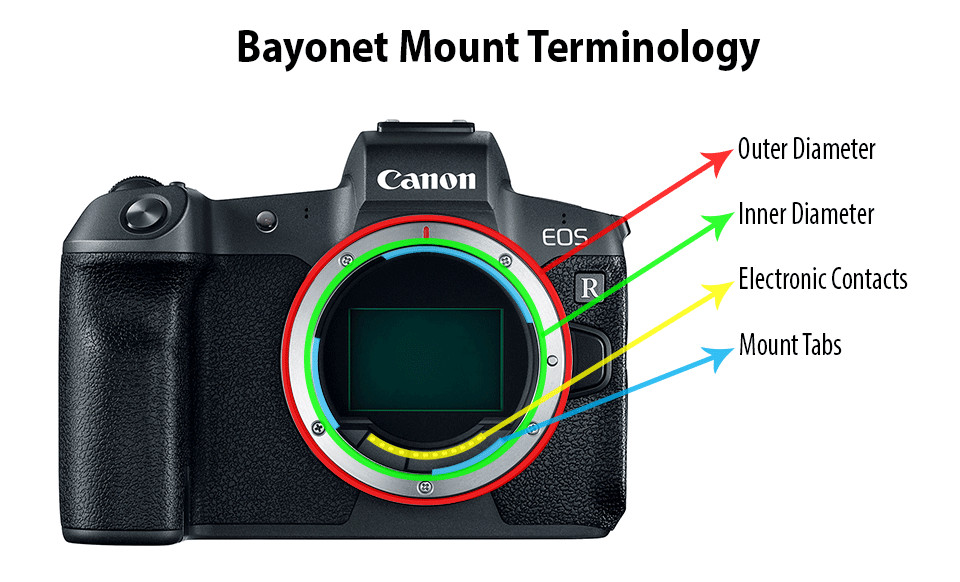
The locking machinery is mechanical, with a spring-loaded pivot locking the lens in place in its proper position, requiring the pin to be retracted when a lens needs to be discrete (which is done using a button adjacent to the camera mount). The bayonet mountain has a number of advantages compared to other mounts, which is why they are the nigh popular today. First, it makes it quick and easy to attach and detach lenses. 2d, it allows for a tight and precise fit, which is specially important when shooting with modern high-resolution cameras, as whatsoever sort of wobble or play could end up negatively affecting parts of the epitome. And lastly, a bayonet mount also allows for like shooting fish in a barrel incorporation of electronic contacts between lenses and cameras to enable two-fashion communication.
Due to the proprietary nature of all camera mounts, each one of them tin differ in mounting direction, mount size, flange altitude, number of electronic contacts and even where the electronic contacts are physically placed. Let'southward take a look at each in more item.
Mounting Direction
While near lens mounts require attaching lenses past twisting them clockwise, some brands similar Nikon have a reversed way of doing it. On i hand, information technology does not thing which direction a lens is mounted or dismounted, simply on the other manus, it might cause some defoliation and might take time to get used to it, especially for those who make up one's mind to switch brands. Below is a table that summarizes the mounting direction of lenses among the popular photographic camera brands.
Delight note that the mounting direction is relative to the front view of the camera.
| Brand | Attaching Direction | Detaching Direction |
|---|---|---|
| Catechism | Clockwise | Counter-Clockwise |
| Fujifilm | Clockwise | Counter-Clockwise |
| Leica | Clockwise | Counter-Clockwise |
| Nikon | Counter-Clockwise | Clockwise |
| Olympus | Clockwise | Counter-Clockwise |
| Pentax | Clockwise | Counter-Clockwise |
| Sony | Clockwise | Counter-Clockwise |
Mount Size (Throat Size, Inner and Outer Diameters)
When information technology comes to mount size, in that location are a few important measurements that demand to be washed correctly, especially when a lens mount is being compared to another one (as you want to compare apples to apples). There is pharynx size, inner diameter and outer bore, and all of them mean different things. Allow'southward take a look at unlike measurement criteria and their differences.
Throat Size
The pharynx size of a lens mount is the inner bore of a mount, minus the tabs that are used to mount lenses. Pharynx size gives u.s. a more accurate representation of the potential of the mount and is important for calculating the angle of incidence, which nosotros volition discuss beneath.
Take a look at the beneath prototype to understand how the throat size is measured on a organisation:
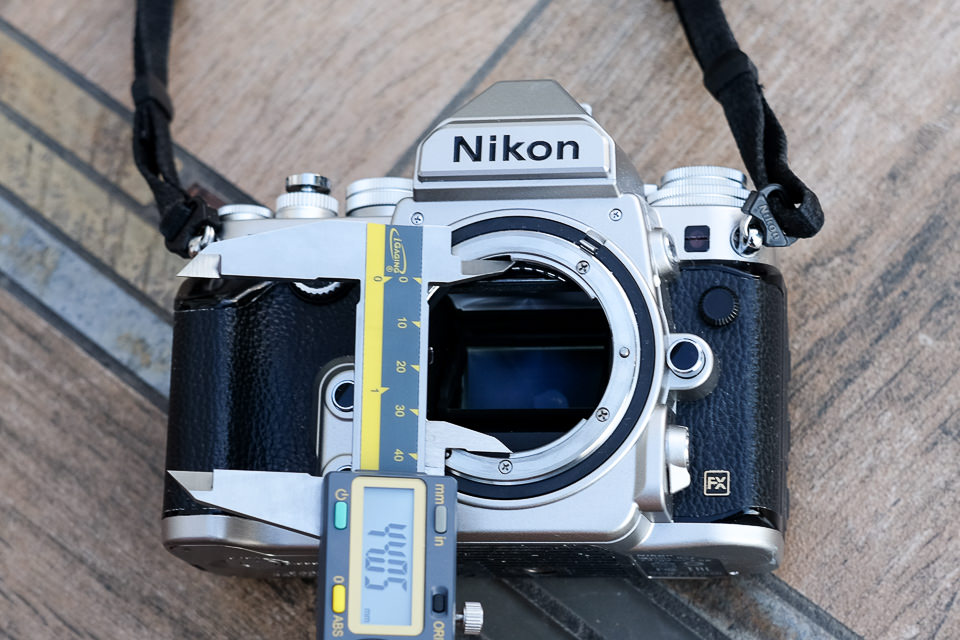
As you lot tin see, the distance measured is between the ii tabs on the inner side of the mountain.
Inner Diameter
The inner diameter of a lens mount represents the size of the lens opening ignoring the tabs on the mount. This measurement is oftentimes provided by photographic camera manufacturers to requite us an idea of the overall size of the lens mountain.
Below is the paradigm of how the inner bore of a lens mount is measured:
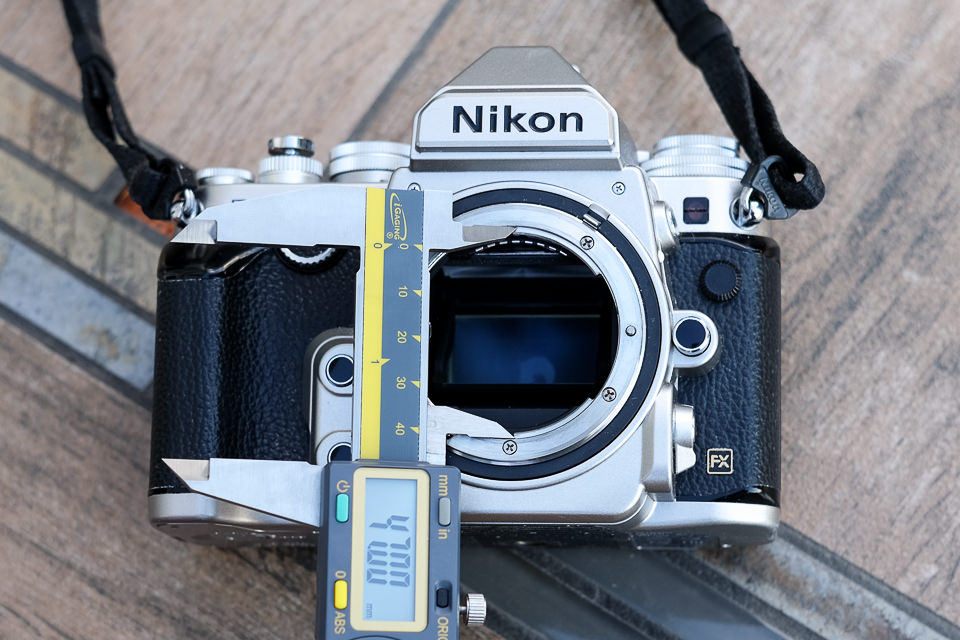
Delight note that the measurement is taken of the outermost inner part of the mountain here. Due to the small boosted recess within the inner mountain in the case of Nikon F, there is an additional loss of 0.5mm to articulate it. Hence, while the inner bore is 47mm equally measured above, it is technically 46.5mm between the inner parts of the mount.
Outer Diameter
The outer bore of a lens mount is the full diameter of the bayonet mount, which in most cameras represents the end of the metallic mount. The outer diameter of the mount plays an important office in determining the approximate outer diameter of the rear part of a lens, as it must be able to wrap itself over the outer diameter.
Here is the image of how the outer diameter of a lens is measured:
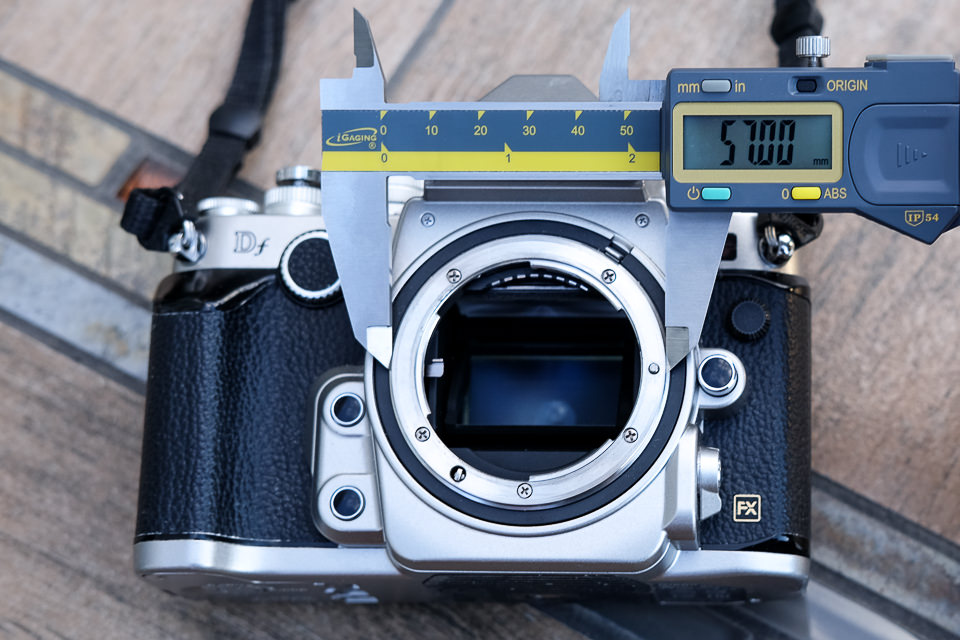
Again, in that location is another minor recess that is correct below the outer office of the mount, but we practice not measure the outer diameter from it.
Flange Distance
Flange distance, as well known equally "flange focal altitude", "flange back distance" or simply "register", is the distance betwixt the mounting flange (which is the outer office of the lens mount when viewed from the side) and the motion picture/sensor plane. Just similar different mounts have differences in pharynx size, inner and outer diameters, flange distances as well often vary greatly between different camera systems.
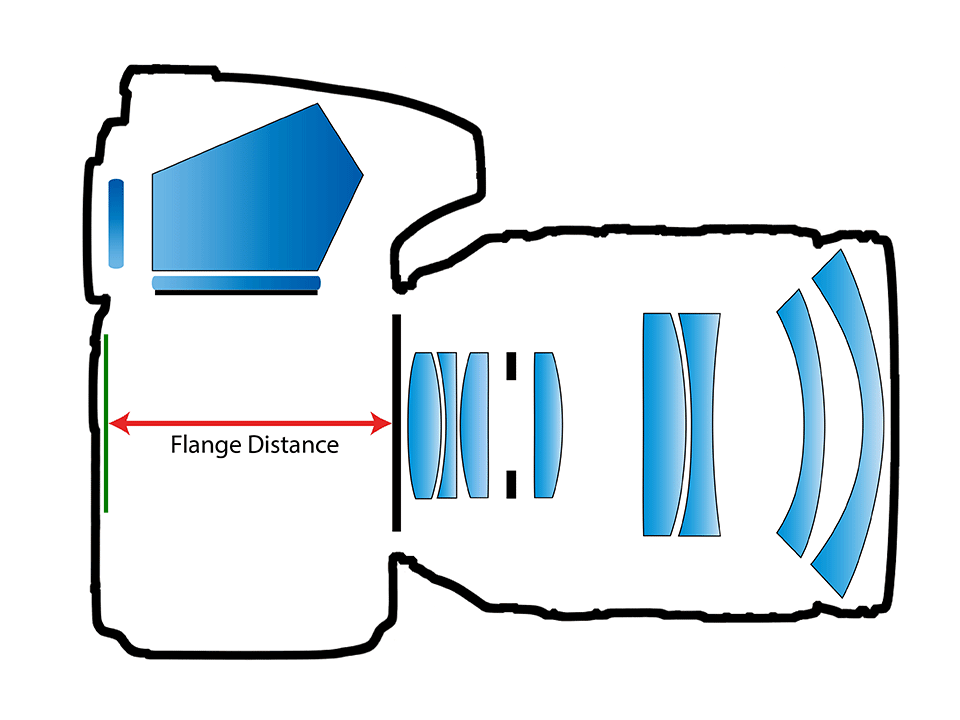
Mountain Size, Flange Distance and the Angle of Incidence
Now that nosotros have divers the mount size and the flange altitude, let'due south talk about the pros and cons of large vs small mount sizes, every bit well every bit the bear on of the flange distance on a system.
The size of the mount is an important cistron in a camera system. Generally, a larger mount size allows for larger lenses that tin provide more light to the sensor. Hence, faster lenses can be designed by optical engineers. At the same time, mount bore is not the merely variable that impacts lens design – flange distance is also equally important. Shorter flange distance allows lenses to be placed closer to the sensor, which in itself allows lens manufacturers to start building simpler, smaller, lighter and less expensive short-focus lenses instead of the retro focus types.
A shorter flange altitude also allows designing thinner cameras, thus making them smaller and lighter compared to cameras with longer flange distances. In addition, it allows lens designers to place a more powerful actuator on lenses for faster autofocusing and makes it possible to conform lenses from other photographic camera systems with longer flange distances via adapters. Lastly, the throat diameter combined with flange altitude determines the maximum possible bending of incidence of the marginal rays from the lens, which is of import in designing lenses – more often than not, the larger the angle of incidence, the easier information technology is to make high-performance lenses.
I downside of a larger lens mount is lens size and weight bug. The larger the throat diameter, the larger the lens has to exist at its mount point, which manifestly does impact its overall thickness and weight every bit well. Besides, the shorter flange altitude tin can lead to increased vignetting or discoloration in the corners of an image (although this can exist mitigated by making the lens design longer to simulate a longer flange altitude), due to sensor microlenses not existence able to pass enough light at extreme ray angles.
To sympathise the importance of a larger mount and a shorter flange distance, please bank check out the beneath video from a Nikon engineer that explains the benefits of the Nikon Z system when compared to Nikon F:
When adapting lenses from other mounts, it is important to point out that due to the proprietary nature of autofocus systems, differences in exchange of information between photographic camera body and lens via electronic contacts (the number of which as well vary from system to system) and other issues, most adapters terminate upwardly being "dumb" adapters with manual controls, manufactured by third party companies. Camera manufacturers themselves ofttimes provide adapters with the release of shorter flange distance systems to be able to mount lenses from other camera mounts that they adult in the by, but they near never provide adapters for competing systems.
In improver, some adapters are capable of changing the physical backdrop of lenses past using drinking glass elements in them, while others make it possible to insert a lens filter (such as neutral density or polarizing filter), making it possible to apply filters on wide-angle lenses with oversized forepart elements, without involving bulky filter mounting rigs and large filters. When adapting lenses from other systems, information technology is of import to make sure that the target lens mount has a longer flange altitude in order to exist able to achieve infinity focus. Furthermore, the deviation in flange distance between the source and the target system has to be large enough to have enough room for an adapter to sit betwixt the lens and the camera for a dumb adapter. Smart adapters that tin can establish advice between the camera and the adjusted lens must have fifty-fifty more legroom for contacts and electronics to fit between the two.
Camera Mountain Comparing
At present that we have gone through all the terms and definitions, permit's go ahead and compare unlike camera mounts based on their throat and inner diameters, as well every bit flange distance and angle of incidence:
| Clarification | Throat Diameter | Inner Diameter | Flange Altitude | Bending of Incidence | Format |
|---|---|---|---|---|---|
| Leica M | xl.0mm | 44.0mm | 27.8mm | 16.05° | Full Frame |
| Fujifilm X | 40.7mm | 43.5mm | 17.7mm | 35.34° | APS-C |
| Minolta SR | 42.0mm | 45.0mm | 43.5mm | xi.69° | Total Frame |
| Sony E | 43.6mm | 46.1mm | 18.0mm | 28.58° | Full Frame |
| Nikon F | 44.0mm | 47.0mm | 46.5mm | 12.14° | Full Frame |
| Pentax K | 44.0mm | 48.0mm | 45.5mm | 12.forty° | Full Frame |
| Leica 50 | 48.8mm | 51.0mm | 19.0mm | 33.xiii° | Full Frame |
| Catechism EF | 50.6mm | 54.0mm | 44.0mm | sixteen.82° | Full Frame |
| Canon RF | 50.6mm | 54.0mm | 20.0mm | 33.62° | Total Frame |
| Nikon Z | 52.0mm | 55.0mm | 16.0mm | 41.19° | Total Frame |
| Fujifilm G | 62.1mm | 65.0mm | 26.7mm | 28.67° | Medium Format |
Annotation
To find the angle of incidence, I calculated the angle betwixt the throat bore and the top middle of each system's camera sensor. I causeless all total-frame sensors to exist 24mm in height, the Fuji X camera sensor to exist xv.6mm in peak, and the Fuji G camera sensor to exist 32.9mm in height (note that other websites sometimes practice this adding with inner mount bore rather than the throat diameter, and they may summate from a corner or the center of the camera sensor rather than the top center).
Frequently Asked Questions
Below is a list of FAQs related to lens mounts that I put together for our readers:
What are the dissimilar camera mounts?
While many photographic camera mounts have existed in the past, the most pop photographic camera mounts today are: Canon EF, Canon RF, Fujifilm 10, Fujifilm Yard, Leica L, Leica Chiliad, Nikon F, Nikon Z, Pentax K and Sony Eastward. Each one differs from each other by a combination of throat bore and flange distance.
How do I know which lens mount my camera has?
Find your camera'south make and model, then search for its manual online. The manual should comprise data relative to the mount, also as a list of uniform lenses. Another pick is to look upward the lens that is mounted on your camera – its description should comprise the name of the mount.
Which lens mountain is the best?
While all lens mounts accept their strengths and weaknesses, lens mounts with the largest throat size and shortest flange distance typically provide the virtually flexibility for lens design. At the moment, Nikon Z, Canon RF and Leica 50 mounts have the largest throat diameter and shortest flange distance among full-frame cameras.
Are all Nikon lens mounts the aforementioned?
No, they are not. Nikon has ii different lens mounts: Nikon F and Nikon Z. The former is for Nikon's DSLR cameras, while the latter is for Nikon'due south newer mirrorless cameras.
Are camera lenses universal?
Unfortunately, they are not. Bated from a couple of alliances, most camera manufacturers typically create their own proprietary mounts, resulting in many different lenses for different lens mounts. However, some third-party lens manufacturers brand the same lens for different camera mounts.
Can you mount a Canon lens on a Nikon camera?
It depends on the lens mount. You cannot mount a Canon EF lens on a Nikon F camera, considering the Catechism EF mount has a shorter flange altitude. Nevertheless, it is technically possible to mount a Catechism RF lens on a Nikon Z photographic camera.
What is a lens mount adapter?
A lens mount adapter is a device that allows a lens from ane camera mount to be used on a photographic camera with a dissimilar mountain. While some manufacturers provide lens mountain adapters with full compatibility and autofocus features, nigh adapters are "dumb", and cannot transmit electronic data.
Please annotation that the above data is based on my inquiry and submitted data from our readers. If you utilize a system that is non listed in the tabular array and would like to assist aggrandize it with more than data, please utilize the images in this commodity to properly mensurate the lens mount, and then provide the data in the comments section below. We volition do our best to update the tabular array equally soon as possible!
phillipskness1999.blogspot.com
Source: https://photographylife.com/what-is-lens-mount
0 Response to "How to Know if You Have the Right Flange Size"
Post a Comment